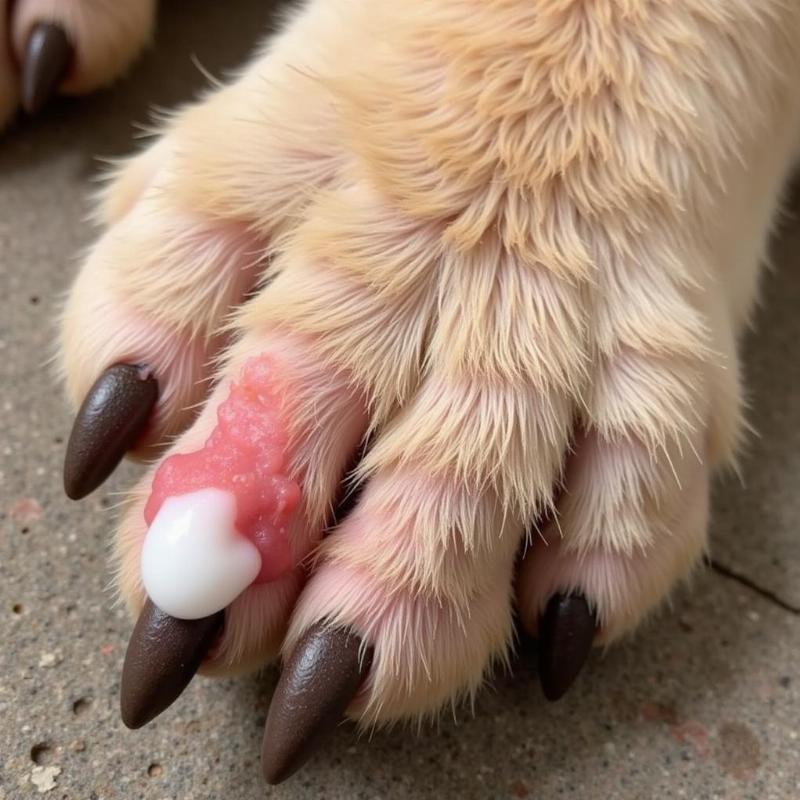Plumerias, with their vibrant colors and intoxicating fragrance, are a popular addition to many gardens across the US. But if you’re a dog owner, you’re probably wondering, are plumerias toxic to dogs? The short answer is yes. All parts of the plumeria plant, from the leaves and flowers to the bark and sap, contain toxins that can be harmful to your furry friend.
While not always fatal, ingestion of any part of the plumeria plant can cause a range of unpleasant symptoms in dogs. Understanding the potential dangers and taking preventative measures can help you protect your beloved canine companion from plumeria poisoning. This article will delve into the specifics of plumeria toxicity in dogs, discuss the symptoms to watch out for, and provide advice on what to do if your dog ingests this tropical beauty.
Understanding Plumeria Toxicity in Dogs
Plumerias contain a milky sap that is irritating to the skin and especially toxic when ingested. This sap contains cardiac glycosides, which disrupt the normal functioning of the heart. While the concentration of these toxins varies depending on the specific variety of plumeria, it’s best to err on the side of caution and consider all parts of the plant poisonous to dogs. Even dried plumeria flowers can retain their toxicity, posing a risk to curious pups.
 Plumeria Sap on Dog Skin
Plumeria Sap on Dog Skin
The severity of the reaction depends on the amount of plant material ingested and the size of the dog. Smaller dogs are naturally more susceptible to the effects of toxins. While rare, severe cases of plumeria poisoning can lead to heart problems and even death.
Signs and Symptoms of Plumeria Poisoning in Dogs
Recognizing the signs of plumeria poisoning is crucial for prompt treatment. If your dog has ingested any part of a plumeria plant, watch for the following symptoms:
- Vomiting
- Diarrhea
- Drooling
- Loss of appetite
- Lethargy
- Abdominal pain
- Skin irritation (from contact with sap)
- Irregular heartbeat (in severe cases)
If you notice any of these symptoms, especially in conjunction with evidence of plumeria ingestion (e.g., chewed leaves or flowers near your dog), contact your veterinarian immediately.
What to Do if Your Dog Ingests Plumeria
Swift action is key in cases of suspected plumeria poisoning. Here’s what you should do:
- Remove your dog from the area: Prevent further access to the plumeria plant.
- Check your dog’s mouth: Remove any remaining plant material.
- Contact your veterinarian or the ASPCA Animal Poison Control Center: Provide them with information about your dog’s breed, weight, the amount of plumeria ingested (if known), and the symptoms they are exhibiting.
- Follow your veterinarian’s instructions: They may induce vomiting or administer activated charcoal to absorb the toxins. In severe cases, intravenous fluids and other supportive care may be necessary.
Preventing Plumeria Poisoning in Dogs
The best way to protect your dog from plumeria poisoning is to prevent access to the plant. Consider the following preventative measures:
- Fence off plumeria plants: Create a barrier to prevent your dog from reaching them.
- Supervise your dog outdoors: Especially in areas where plumerias are present.
- Train your dog to “leave it”: This command can be invaluable in preventing them from investigating potentially harmful plants.
- Consider alternative landscaping options: If you live in an area where plumerias are common, choose dog-friendly plants for your garden.
Conclusion
While plumerias add a touch of tropical beauty to our landscapes, they pose a potential threat to our canine companions. Understanding the risks associated with plumeria toxicity and taking proactive steps to prevent exposure is essential for responsible dog ownership. By being vigilant and informed, you can keep your dog safe and happy while still enjoying the beauty of these fragrant flowers. Remember, if you suspect your dog has ingested plumeria, immediate veterinary care is crucial.
FAQ
- Are all parts of the plumeria plant toxic? Yes, all parts of the plumeria plant, including the leaves, flowers, bark, and sap, are toxic to dogs.
- What are the most common symptoms of plumeria poisoning in dogs? The most common symptoms include vomiting, diarrhea, drooling, loss of appetite, and lethargy.
- What should I do if my dog eats a plumeria flower? Contact your veterinarian or the ASPCA Animal Poison Control Center immediately.
- Can plumeria poisoning be fatal to dogs? While rare, severe cases of plumeria poisoning can be fatal.
- How can I prevent my dog from being poisoned by plumerias? The best way to prevent plumeria poisoning is to prevent access to the plant. Fence off plumerias, supervise your dog outdoors, and train them to “leave it”.
- Are there any dog-friendly alternatives to plumerias? Yes, there are many dog-friendly plants that can be used in landscaping. Consult with your local nursery or gardening center for recommendations.
- What is the toxic substance in plumerias? Plumerias contain cardiac glycosides, which are toxic to dogs.
Beautdogs.us is your leading online resource for all things dog-related in the United States. We offer expert advice on dog breeds, care, and products. Whether you’re a new dog owner or a seasoned pro, Beautdogs.us has the information you need to ensure your furry friend lives a long, healthy, and happy life. For any questions or concerns, contact us at [email protected] or call us at +1 501-555-7529.